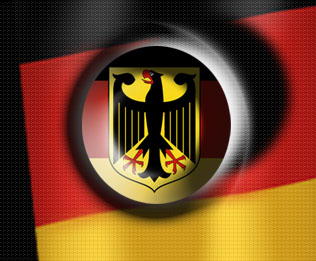Symbol of a city: Berlin's TV tower turns 40
 Berlin - During the 2006 World Cup the sphere of Berlin's television tower, the Fernsehturm, was decorated to look like a football. Recently its column was painted in love messages and it provides an all-year round backdrop for countless tourist photos. October 3 marked the 40th anniversary of the construction of what has come to be a favourite of all Germans since the fall of the Wall.
Berlin - During the 2006 World Cup the sphere of Berlin's television tower, the Fernsehturm, was decorated to look like a football. Recently its column was painted in love messages and it provides an all-year round backdrop for countless tourist photos. October 3 marked the 40th anniversary of the construction of what has come to be a favourite of all Germans since the fall of the Wall.
Together with the Brandenburg Gate and the Reichstag's glass dome,
the 368-metre-high Fernsehturm with its silver-coloured sphere is a symbol of the German capital. Its image can be found on t-shirts, mugs and kitschy souvenirs of all kinds.
Long queues of visitors can be found at its elevators waiting to be transported to the viewing platform just as they have been doing for the past 40 years.
It is perhaps a little ironic that the Fernsehturm, constructed in Communist East Germany with a mixture of engineering mastery and megalomania, celebrated its birthday on Germany's Reunification Day.
In 1969 when it was completed the date October 3 had a different meaning. The tower's completion after four years of construction was the start of celebrations to mark East Germany's 20th anniversary. The East German state would never pass its 40th birthday.
"So comrades, we can clearly see that it belongs there" were the words reportedly spoken by East German leader and party boss Walter Ulbricht in September 1964 as he pointed to a spot near Alexanderplatz on a model of central Berlin.
That moment had been proceeded by 10 years of discussion over where the tower should be built. In the end Ulbricht and the government's planning collective opted for a place right in the middle of the East German capital.
Later, a bizarre argument ensued as to who had designed the tower. That argument continues to this day among the widows of the tower's planners. The truth is probably that it was collective teamwork that created the Fernsehturm.
The tower's shape definitely reflects the mood and technical standards of the 1960s. Its sphere is mounted on an elegantly narrow concrete column and houses a viewing platform and a revolving restaurant. It recalls Soviet Russia's triumph of sending Sputnik into space.
Its profile also bears a resemblance to a rocket and there were even plans to paint the sphere in red, the colour of socialism. However, despite its modern design it was not long before the tower was scoffed at.
Just as the Communist Party's leaders were speaking about the tower as "World Class," observers in east and west Berlin noticed an unusual reflection of light on the sphere's steel surface. As soon as the sun shone a cross would appear on the sphere. Locals called it God's revenge for East Germany's avowedly atheist outlook.
It was during this time that one of the tower's nicknames -- "St Walter" -- was thought up as a sideswipe at the country's leader. Over the years the tower has been given other names including "Telespargel" (TV asparagus).
The tower's construction caused a lot of bother for its builders. Its budget ran to 200 million East Marks - about six times more than the original projected cost. It swallowed up enormous sums of foreign currency. The tower's double glazed windows were made in Belgium, its elevators and air conditioning came from Sweden. The crane drivers who worked on the project recall using brand new walkie-talkies to guide building elements into place.
But the arguments about the tower's cost were quickly put to side when the Tele Cafe opened for the first time. The revolving restaurant with its astonishing view to the west was one of the most popular cafes in East Berlin.
A menu from 1969 bears the image of a staff member in stewardess look, with a white bonnet atop back-combed hair, wishing guests a pleasant stay. Real tortoise soup cost 2.55 East Marks, ragout fin 6.35 and a glass of East German cola 1.65. Guests could stay for one hour.
One joke told by East Berliners at the time went: "If the Fernsehturm tower falls over at least we'll land in West Berlin."
To this day the landmark tower with its 368 metres is the highest in Germany. It has lost none of its appeal and one million visitors make their way to the viewing platform every year. Berliners are frequent visitors themselves according to statistics.
The tower is owned by Deutsche Telekom which proudly calls the tower the highest publicly accessible building in Europe. It is also the workplace of five broadcast technicians who look after the over 60 channels that are beamed out across the city from its 118-metre-high aerial. (dpa)